Characteristics of silk
Due to its very fine and smooth fiber structure, silk falls supple and soft.
What makes silk so special?
The chemical structure of silk is very similar to our skin and is therefore particularly skin friendly and ideal for allergy sufferers. Silk is said to have skin-soothing properties.
Information on the topic of silk allergy
Naturopathic doctors recommend silk especially for skin diseases. Silk has been shown to provide relief from irritated skin and accelerates wound healing. The high proportion of silk glue (sericin) in bourette silk has a skin-soothing and anti-inflammatory effect. Bourette silk is therefore used particularly for diaper and nursing pads as well as baby clothing. Babies and children with neurodermatitis or psoriasis cannot control the scratching of their skin, especially at night. Treat your child to comfort and protection from scratching without restricting freedom of movement.
Link to the study ...
Silk keeps you warm when it's cold and cool when it's hot. It is therefore perfectly wearable in both summer and winter. Silk can absorb about 30% of its own weight in liquid without feeling damp. It therefore absorbs body sweat very well and allows the skin to breathe. Silk is robust in many ways. Thanks to its smooth surface, it is dirt-repellent and insensitive to odors. Silk is tear-resistant and has the greatest elasticity of all natural fibers.
Did you know?
Up to ten kilograms of cocoons are needed to obtain one kilogram of raw silk.
More than 25 mulberry trees are needed to produce three kilograms of silk.
It takes nearly 70 kilograms of mulberry leaves to make a single silk dress.
The thread of a cocoon can be over 4000 meters long, with an average width of just 20 microns.
A silkworm caterpillar can spin up to 15 meters of silk in a minute during its pupation.
A silk moth multiplies its weight 12,000 times within four weeks of birth.
A silkworm grows 25 times larger during these four weeks.
During its lifetime, a silkworm will eat 40,000 times its body weight of mulberry leaves.
and about half a kilogram of silk moth caterpillars eat nearly 12,000 kilograms of mulberry leaves in their lifetime.
A rope made of metal can carry less weight than a rope made of silk of the same strength.
Source: https://www.die-seide.de/fachartikel/10-fakten-zur-seide/
Physical Properties of Mulberry Silk
Density: 1.25 g/cm³
Fiber thickness: 12-25 µm
Tensile strength: 350 Mpa (Mega Pascal)
Elongation: 24%
Elasticity: the highest of all natural fibers
Moisture absorption up to 30% of its own weight
Wet strength approx. 85% of dry strength
Heat retention: 88%
Flash point: 300...460°C (hardly inflammable)
Resistance to alkalis (alkaline detergents): low
Source: Wikipedia


